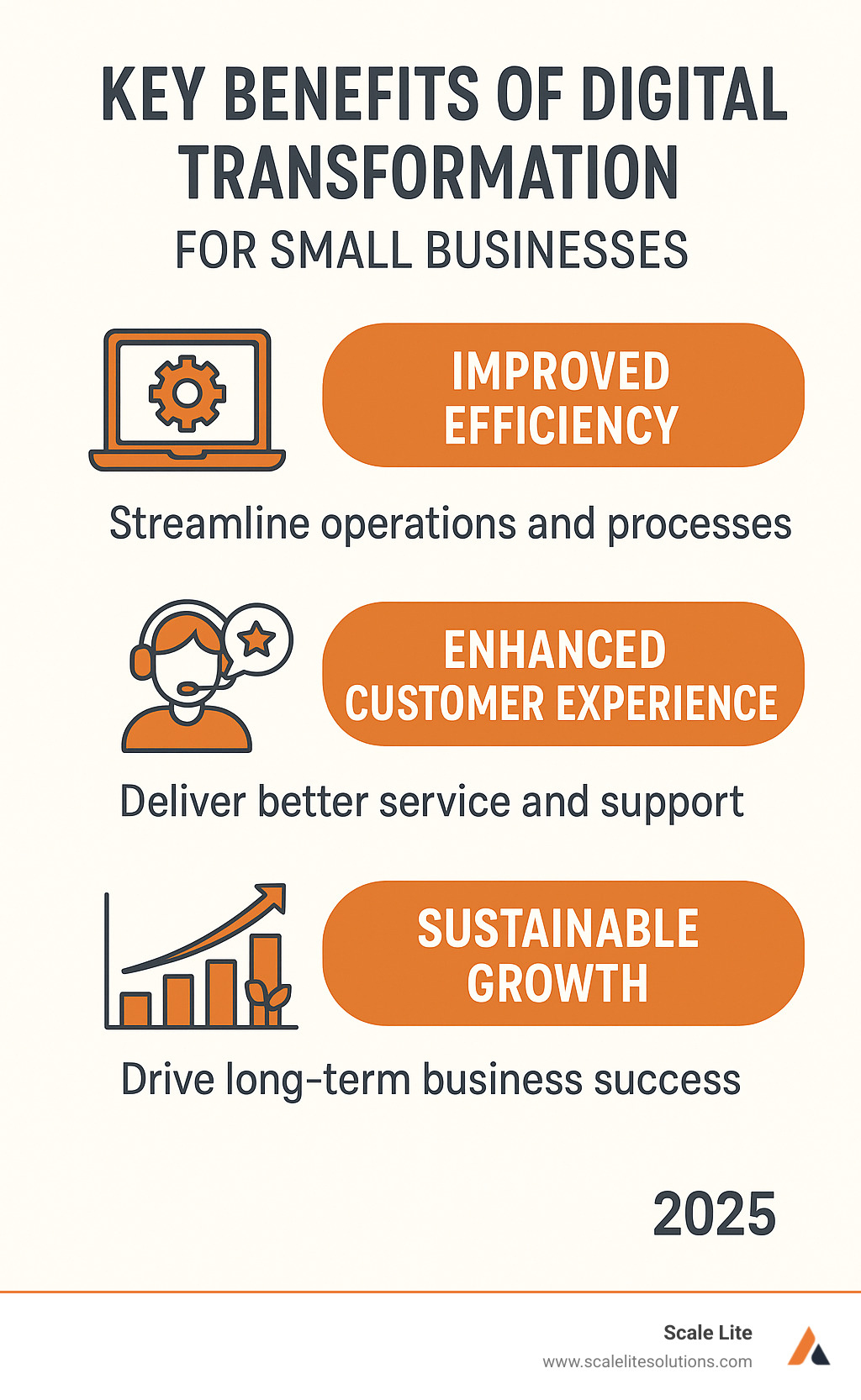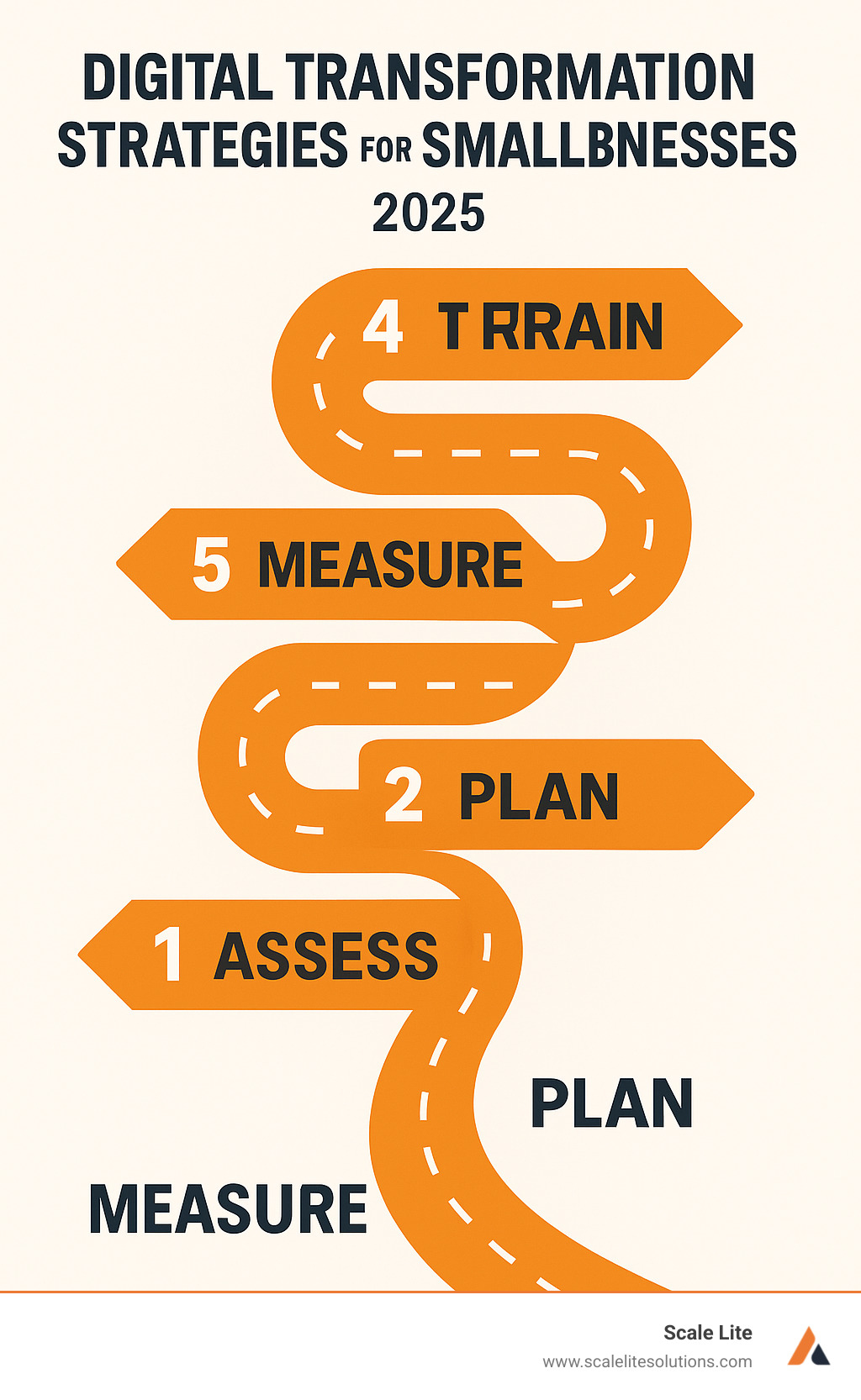
How to Craft Winning Digital Transformation Strategies for Your Small Business

Why Digital Change Matters for Small Businesses
In today's world, understanding digital change strategies for small businesses is no longer optional—it's essential for survival and growth.
Digital change for small businesses involves using digital tools and processes to:
- Improve customer experiences.
- Improve operational efficiency.
- Drive sustainable business growth.
Digital change might sound like a big, scary tech term. But think of it like a major home renovation, as experts often describe it. You're not just adding a new smart gadget; you're rethinking your entire business space. It's about fundamentally changing how your business operates and delivers value to customers, moving beyond just buying new software. This strategic shift helps your business adapt, stay competitive, and meet the evolving demands of today's market.
As the founder of Scale Lite, I've spent years helping blue-collar and service-based business owners implement effective digital change strategies for small businesses, focusing on building scalable and sellable companies. My experience in private equity and enterprise software has shown me how structured operations and modern tools can open up significant value and reduce owner dependence. This guide will walk you through practical steps to achieve these same results.

Why Digital Change is No Longer a Choice, But a Necessity
If your competitor launches an online booking system while you're still using a paper calendar, you're already behind. Digital change strategies for small businesses have shifted from a "nice-to-have" to an absolute necessity for survival. Delaying this change means choosing a slower, more expensive path while your competition speeds past.
Today's customers expect immediate responses, easy online services, and seamless experiences. If your business isn't digitally accessible, you're invisible to a growing number of potential customers who research, read reviews, and compare prices online before making a decision.
The numbers tell a compelling story. Recent surveys show that 51% of digital change efforts arise from growth opportunities, while 41% are driven by competitive pressure. The results are clear: small businesses that prioritize digital change have seen double the revenue growth compared to their less-adapted peers. In fact, 56% of CEOs report that digital improvements have directly increased their revenue.
For blue-collar and service-based businesses, this is a massive opportunity to streamline operations, improve customer interactions, and drive greater enterprise value. The goal isn't just survival—it's achieving operational excellence. You can learn more by exploring business process streamlining.
Enhancing the Customer Experience
Think about a time you had a frustrating customer experience. Digital tools can prevent that by providing instant, 24/7 support and personalized interactions. Nearly half of all companies cite improving customer experience and satisfaction as the main reason for starting their digital journey.
Automated systems can handle common inquiries anytime, freeing up your team for more complex issues. This improves customer satisfaction and reduces operational costs. The backbone of this is a Customer Relationship Management (CRM) system, which provides a complete view of each customer. This data allows for proactive service and targeted communication that feels personal, not generic, leading to increased loyalty and sales.
Your Practical Roadmap: Crafting Digital Change Strategies for Small Businesses
Feeling a bit overwhelmed by the idea of digital change? Don't be! While it might sound like a huge undertaking, changing your business doesn't have to be a scary, all-at-once overhaul. Instead, think of it as a journey you take one step at a time. We believe in a practical, step-by-step approach that focuses on making small, impactful improvements. Digital change isn't a finish line; it's an ongoing trip where you continuously adapt and improve.
It's all about starting small, picking the areas that will bring the most benefit, and treating this whole process as an exciting evolution for your business.
Here’s a simple 5-step roadmap to guide your journey:

Step 1: Assess Your Current Operations and Define Clear Goals
Before you buy any fancy new software, let's take a good, honest look at where your business stands right now. This first step is like a "digital health check" or audit. It means diving into your current tools and processes to spot those annoying bottlenecks or inefficiencies that are slowing you down. Ask yourself:
- Which manual tasks eat up too much of your day?
- Where are you seeing waste, either in time or resources?
- Are there any systems you're using that just don't play well together, causing headaches?
Once you have a clear picture of what's happening now, you can set smart, clear goals for your digital improvements. Instead of just saying, "I want to be more digital," try something like, "We will cut down customer service response time by 20 % using a new chatbot system within six months." This kind of clarity ensures that every digital move you make serves a real, tangible business goal. To learn more about how to approach this crucial first stage, dive into the assessment phase of digital change.
Step 2: Create a Focused Plan and Prioritize Initiatives
With your goals firmly in mind, it's time to build a clear, step-by-step plan. This means setting realistic timelines, figuring out who on your team will do what, and setting aside a sensible budget. We always suggest looking for "quick wins" first – those projects that are high-impact but low-risk. They deliver immediate value, which helps build confidence and momentum for bigger changes.
Think back to those pain points you identified in Step 1. Which digital change strategies for small businesses can fix those problems most effectively without turning your whole operation upside down? This focused approach helps you avoid feeling overwhelmed and makes sure every penny you spend aligns with your business's vision. Creating a technology roadmap that sketches out both your immediate and long-term digital plans will give you a clear path forward. For more detailed insights into strategy, check out our digital change planning guide.
Step 3: Select and Implement Foundational Technologies
Now for the exciting part: choosing the digital tools that will bring your plan to life! The trick here is to pick solutions that are easy to use, can grow with your business (scalable), and play nicely with your existing systems. You don't want a bunch of separate tools that create more work later on.
When thinking about foundational technologies for small businesses, consider these key areas:
- Customer Management Tools: These are often called CRMs. They help you keep track of all your customer interactions, manage sales leads, and offer personalized support. They give you a complete picture of your customers, leading to better engagement and service.
- Cloud-based Productivity Solutions: Imagine tools for working on documents together, chatting with your team, and managing projects – all online! These make remote work easier, streamline internal tasks, and boost team communication.
- Workflow Automation Tools: These are like having a super-efficient assistant that handles repetitive tasks such as invoicing, data entry, or scheduling. By automating these, you reduce errors, save heaps of time, and free up your team for more important work.
- Digital Marketing Platforms: These help you connect with customers online, whether it's through email campaigns, social media, or understanding who visits your website. They give you insights into what works best to reach your audience.
- Financial Management Software: These tools simplify your accounting, track expenses, and manage payroll. They give you a clearer view of your money, helping you stay in control.
It's worth noting that artificial intelligence (AI) and cloud computing are like the magic ingredients making all these tools better. AI can power smart chatbots for customer help, dig out insights from your data, and automate complex tasks. Cloud computing gives you the flexible, scalable tech foundation you need to run these advanced tools without a massive upfront investment. We always recommend choosing tools that are affordable, simple to use, and clearly make a positive difference. Learn more about how these automation and business platforms can work for you in our dedicated overview here.
Step 4: Empower Your Team Through Training and a Digital-First Culture
Here's the secret: new tech alone won't transform your business. Your people will! For digital change to truly stick, your team needs to accept it. This means tackling any fears about change head-on, explaining why these changes are happening, and giving everyone the training they need.
Get your team involved early. When employees understand how new tools will make their daily work easier, more efficient, or even more fun, they'll be much more open to them. Provide hands-on training sessions, workshops, and ongoing support so everyone feels confident and capable with the new tech. As learning-and-development analyst Josh Bersin notes in the HR Technology Report, "Rushing training is a sure way to fail; proper enablement is as important as the technology itself." We need to invest in our current staff through training programs to address any talent shortages.
Leadership support is absolutely key here. When you, as a leader, champion digital initiatives and show how excited you are about them, it inspires others to follow. Build a "digital-first" culture where new ideas are welcomed, and everyone feels supported. This empowers your team to become part of the solution, not a barrier to change.
Step 5: Measure, Analyze, and Refine with Data
Your digital journey is ongoing, and measuring your progress is how you make sure you're always heading in the right direction. From the very start, set up clear Key Performance Indicators (KPIs) to track your success. These might include:
- Operational Efficiency: How much time are you saving on tasks? Are there fewer manual errors? How quickly are processes getting done?
- Customer Satisfaction: Are your customers happier? Look at scores like Customer Satisfaction Score (CSAT) or Net Promoter Score (NPS), and how many customers you keep over time.
- Financial Impact: Are you saving money? Is revenue growing? Are profits up? Don't forget to calculate your Return on Investment (ROI). For example, if you spend $3,000 and gain $10,000 in benefits, that's an impressive 233 % ROI!
Regularly checking these KPIs helps you turn raw data into smart decisions. Use your data to refine processes, improve customer experiences, and make better choices overall. Treat your data as a valuable asset, making sure it's accurate and always up-to-date. This constant feedback loop helps you see what's working, what needs a tweak, and where to focus your next digital efforts. It's no wonder that 85 % of small and mid-sized businesses that adopt AI expect to see a return on their investment – that's the power of data-driven approaches! For more details, dive into our guide on AI-driven workflow automation.
Navigating Common Problems on Your Digital Journey
Starting your digital change strategies for small businesses is an exciting trip, but it's totally normal to hit a few bumps along the way. Many small business owners, just like you, might worry about things like limited budgets, not having enough tech know-how, or even getting the team on board. In fact, studies show that things like how complex the tech environment is (32 %), a lack of technical experts (27 %), and high costs (26 %) are big problems for business leaders. But here's the good news: don't let these challenges scare you off! With a little planning and some clever solutions, you can steer this maze successfully.

Overcoming Budget Constraints and Proving ROI
For small businesses, every single dollar truly counts. The idea of "high costs" can feel like a huge roadblock, right? But here's a secret: digital change strategies for small businesses don't have to break the bank! The trick is to start small. Focus on tools that offer a big impact without a huge price tag. Then, roll them out in phases. This way, you can test things out, learn as you go, and show off the value before committing to bigger investments.
It's smart to pick projects that can show a clear, measurable return on your investment (ROI) pretty quickly. For example, automating just one manual task that eats up a lot of time can immediately save you hours and reduce mistakes. This first success can then build confidence and easily justify putting more money into digital improvements down the road.
Let's look at the difference a simple automation can make:
| Feature | Manual Process (e.g., invoice generation) | Automated Process (e.g., invoice generation) |
|---|---|---|
| Time per invoice | 10 minutes | 1 minute |
| Cost per invoice | $5 (labor) | $0.50 (software + minimal labor) |
| Error Rate | 5 % | <0.1 % |
| Scalability | Limited, requires more staff | High, handles increased volume easily |
See? Even small changes can lead to big savings and make things much more efficient. This table really shows how much value a smart digital investment can bring.
How to Make Your Digital Change Strategies for Small Businesses Cost-Effective
Beyond just starting small, there are many clever ways to make your digital change strategies for small businesses more affordable.
- Look into grants and tax incentives – Many local and national programs exist specifically to help small businesses adopt new technology, sometimes covering up to half your project costs.
- Partner with technology providers or consultants – External experts can fill skill gaps and speed up implementation without the cost of hiring full-time staff.
- Use fractional teams for specialized tasks – Bring in top-tier talent on a part-time or project basis for things like AI setup or CRM optimization.
- Explore bundled software solutions – Many vendors offer packages that combine several must-have tools at a lower total cost.
By smartly using these resources, you can achieve amazing digital improvements without overstretching your budget. Explore a curated list of funding programs and resources that can help support your digital journey.
Why a 'Digital-First' Culture is Key to Your Digital Change Strategies for Small Businesses
Here's the honest truth: technology is just a tool. It's your amazing people and your company culture that truly make digital change happen. A challenge can be when your team resists new ways of doing things. Without their buy-in, even the best digital tools might not reach their full potential.
To truly build a "digital-first" culture:
- Communicate clearly and often – Explain why digital changes are happening and how they'll directly benefit employees.
- Lead by example – When leadership eagerly adopts new tools, it signals that the change is positive and supported.
- Make technology accessible – Provide user-friendly tools, hands-on training, and ongoing support so everyone feels comfortable.
- Celebrate small wins – Acknowledge early successes to build momentum and reinforce positive behavior.
- Keep the conversation inclusive – Ensure discussions about digital initiatives include every level of your organization.
By focusing on this cultural shift, you ensure your digital tools aren't just installed, but truly accepted in daily work. This people-first approach is what ultimately leads to lasting digital growth. For inspiration, take a look at these case studies of small-business digital change.
Frequently Asked Questions about Small Business Digital Change
Let's be honest, diving into digital change strategies for small businesses can bring up a lot of questions. That's perfectly normal! Here are some of the most common questions we hear, answered with a clear, practical approach.
What's the most important first step in digital change?
It's tempting to jump straight to buying the latest software, right? But here's a secret: the most important first step isn't about technology at all. It's about looking inwards.
The absolute best first move is a thorough assessment of your current operations and processes. Think of it like a doctor's check-up for your business. You need to identify your biggest pain points, where things get stuck, and what your team spends too much time on. Where are the bottlenecks? What processes are clunky?
Only after you truly understand your business's needs can you choose the right digital tools. This approach ensures you invest in solutions that genuinely solve problems and deliver immediate, tangible value, rather than just adding new tech for the sake of it.
Can my business transform without a big budget or an IT department?
Absolutely, yes! This is one of the biggest misconceptions about digital change strategies for small businesses. You don't need a massive budget or a dedicated IT team to accept digital.
Digital change is less about spending a fortune and more about being strategic and resourceful. The good news is that many powerful digital tools today are cloud-based and designed to be incredibly user-friendly. This means you don't need expensive servers or a complex IT infrastructure. You can access powerful solutions right over the internet, often with very affordable, or even free, entry plans.
Start small, focus on one or two key areas that will make a big difference, and look for low-cost, scalable solutions. For specialized expertise, don't be afraid to leverage external partners, fractional teams, or consultants. They can provide high-level support and guidance on an as-needed basis, giving you top-tier knowledge without the full-time salary commitment.
How do I get my employees on board with new technology?
This is a fantastic question, because technology is only as good as the people who use it! Getting your team on board is crucial for any successful digital initiative.
First, involve them in the process early. Ask them about their daily frustrations and what tools they think could help. When employees feel heard and part of the solution, they're far more likely to accept change.
Second, clearly communicate the benefits to them. Don't just talk about company goals; explain how the new technology will make their jobs easier, more efficient, or less stressful. For example, "This new system will eliminate 5 hours of tedious paperwork a week, freeing you up for more engaging tasks!"
Third, provide thorough, hands-on training and ongoing support. No one likes to feel lost. Offer workshops, one-on-one help, and create resources that your team can refer to.
Finally, lead by example and celebrate their successes. When you, as a leader, enthusiastically use the new tools, it sets a positive tone. And when an employee successfully adopts a new process or finds an innovative way to use the tech, make sure to acknowledge and celebrate it. This builds momentum and fosters a culture where digital adoption is exciting, not intimidating.
Conclusion: Your Journey to a Smarter, Stronger Business
As we've seen throughout this guide, embracing digital change strategies for small businesses isn't just a trend; it's a vital, ongoing journey. Think of it not as a finish line to cross, but as a continuous path of adapting, learning, and growing. For any small business, this journey is about building a foundation that's more resilient, incredibly efficient, and deeply focused on your customers. It’s how you'll truly thrive in today's market. The potential rewards are huge: happier customers, smoother operations, and a rock-solid base for lasting growth.
The best part? You don't need to do it all at once. The key is simply to start now, even if it's with just a few small, incremental steps. By taking a clear, strategic approach and fostering a culture that's open to new technologies, you'll naturally set your business apart. Especially for blue-collar and service-based businesses, this means using technology to streamline your daily operations, enrich every customer interaction, and ultimately boost the overall value of your enterprise.
At Scale Lite Solutions, we're passionate about helping businesses like yours steer this exciting path. We specialize in crafting custom roadmaps custom just for you. We're here to help small businesses modernize and scale through smart tech, effective marketing, and powerful automation—covering everything from AI deployment and workflow automation to better data gathering and CRM optimization. Our holistic approach is designed with one goal in mind: to boost your operational efficiency and drive sustainable growth, helping you maximize the true value of your business.
Ready to take the next step on your digital journey?






